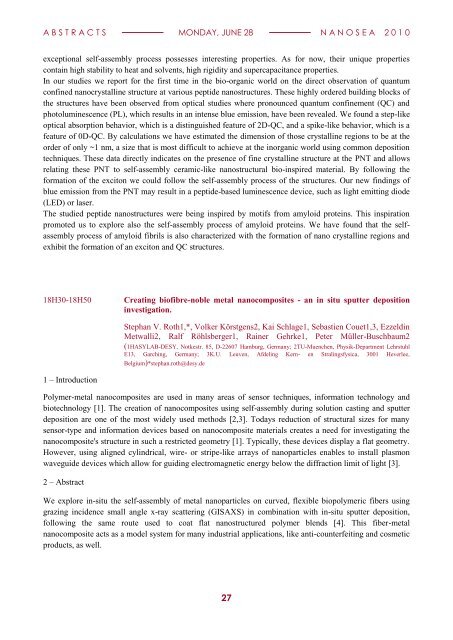book of abstracts - IM2NP
book of abstracts - IM2NP
book of abstracts - IM2NP
You also want an ePaper? Increase the reach of your titles
YUMPU automatically turns print PDFs into web optimized ePapers that Google loves.
A B S T R A C T S MONDAY, JUNE 28 N A N O S E A 2 0 1 0<br />
exceptional self-assembly process possesses interesting properties. As for now, their unique properties<br />
contain high stability to heat and solvents, high rigidity and supercapacitance properties.<br />
In our studies we report for the first time in the bio-organic world on the direct observation <strong>of</strong> quantum<br />
confined nanocrystalline structure at various peptide nanostructures. These highly ordered building blocks <strong>of</strong><br />
the structures have been observed from optical studies where pronounced quantum confinement (QC) and<br />
photoluminescence (PL), which results in an intense blue emission, have been revealed. We found a step-like<br />
optical absorption behavior, which is a distinguished feature <strong>of</strong> 2D-QC, and a spike-like behavior, which is a<br />
feature <strong>of</strong> 0D-QC. By calculations we have estimated the dimension <strong>of</strong> those crystalline regions to be at the<br />
order <strong>of</strong> only ~1 nm, a size that is most difficult to achieve at the inorganic world using common deposition<br />
techniques. These data directly indicates on the presence <strong>of</strong> fine crystalline structure at the PNT and allows<br />
relating these PNT to self-assembly ceramic-like nanostructural bio-inspired material. By following the<br />
formation <strong>of</strong> the exciton we could follow the self-assembly process <strong>of</strong> the structures. Our new findings <strong>of</strong><br />
blue emission from the PNT may result in a peptide-based luminescence device, such as light emitting diode<br />
(LED) or laser.<br />
The studied peptide nanostructures were being inspired by motifs from amyloid proteins. This inspiration<br />
promoted us to explore also the self-assembly process <strong>of</strong> amyloid proteins. We have found that the selfassembly<br />
process <strong>of</strong> amyloid fibrils is also characterized with the formation <strong>of</strong> nano crystalline regions and<br />
exhibit the formation <strong>of</strong> an exciton and QC structures.<br />
18H30-18H50<br />
Creating bi<strong>of</strong>ibre-noble metal nanocomposites - an in situ sputter deposition<br />
investigation.<br />
Stephan V. Roth1,*, Volker Körstgens2, Kai Schlage1, Sebastien Couet1,3, Ezzeldin<br />
Metwalli2, Ralf Röhlsberger1, Rainer Gehrke1, Peter Müller-Buschbaum2<br />
(1HASYLAB-DESY, Notkestr. 85, D-22607 Hamburg, Germany; 2TU-Muenchen, Physik-Department Lehrstuhl<br />
E13, Garching, Germany; 3K.U. Leuven, Afdeling Kern- en Stralingsfysica, 3001 Heverlee,<br />
Belgium)*stephan.roth@desy.de<br />
1 – Introduction<br />
Polymer-metal nanocomposites are used in many areas <strong>of</strong> sensor techniques, information technology and<br />
biotechnology [1]. The creation <strong>of</strong> nanocomposites using self-assembly during solution casting and sputter<br />
deposition are one <strong>of</strong> the most widely used methods [2,3]. Todays reduction <strong>of</strong> structural sizes for many<br />
sensor-type and information devices based on nanocomposite materials creates a need for investigating the<br />
nanocomposite's structure in such a restricted geometry [1]. Typically, these devices display a flat geometry.<br />
However, using aligned cylindrical, wire- or stripe-like arrays <strong>of</strong> nanoparticles enables to install plasmon<br />
waveguide devices which allow for guiding electromagnetic energy below the diffraction limit <strong>of</strong> light [3].<br />
2 – Abstract<br />
We explore in-situ the self-assembly <strong>of</strong> metal nanoparticles on curved, flexible biopolymeric fibers using<br />
grazing incidence small angle x-ray scattering (GISAXS) in combination with in-situ sputter deposition,<br />
following the same route used to coat flat nanostructured polymer blends [4]. This fiber-metal<br />
nanocomposite acts as a model system for many industrial applications, like anti-counterfeiting and cosmetic<br />
products, as well.<br />
27

















